Bednorz W. (ed.) Advances in Greedy Algorithms
Подождите немного. Документ загружается.


Greedy Type Bases in Banach Spaces
331
We take sets as in Lemma 1 and denote
be a set of
cardinality m disjoint with J
2
. Consider
Then
From Proposition 2 we
learn that
This and Lemma 1 give
Since is arbitrary it completes the proof.
■
More elaborate results of this type are presented in [29].
Theorem 3 Let
be natural biorthogonal system with unconditional constant 1. Suppose that s(m)
is a function such that for some c > 0
(7)
Then
for some constants C and m = 0, 1, 2, ….
Proof. Let us fix
with and m = 0, 1, 2, …. By Proposition 2, there exits a
subset J ⊂ I of cardinality m such that
and a subset of cardinality Using
the unconditionality of the system we get
Let The again using unconditionality we derive
(8)

Advances in Greedy Algorithms
332
Since for
we get
(9)
From (8), (9) and (7) we get
so
■
Let
be a biorthogonal system. The natural question rises when is
the unconditional system in X*. The obvious obstacle may be that such system does not
verify (4). For example the standard basis
in l
1
cannot have its dual to be a basis in
since the latter is not separable. However, if we consider it as a system in
span
then it will satisfy all our assumptions and thus we denote such
system by *. Note that if is unconditional then so is *.
Theorem 4 Let
be natural biorthogonal system with unconditional constant 1. Then
for m = 2, 3, ….
Proof. Let us fix and a set of cardinality k. We have
(10)
On the other hand there exists
with such that
(11)
Let
whenever From 1-
unconditionality we deduce that
therefore
(12)

Greedy Type Bases in Banach Spaces
333
Thus from (10),(11) and (12) using the fact that
is decreasing, we obtain that
(13)
■
Theorems 3 and 4 are quoted from [40] but the almost the same arguments were used earlier
in [11] and [27].
3. Greedy bases
The first step to understand the idea of greedy systems in Banach spaces is to give their
characterization in terms of some basic notions. The famous result of Konyagin and
Temlyakov [26] states that being a greedy basis is equivalent to be an unconditional and
democratic basis. We start from introducing these two concepts.
The second concept we need to describe greedy bases concerns democracy. The idea is that
we expect the norm
being essentially a function of rather then from J itself.
Definition 8 A biorthogonal system
is called democratic if there exists a constant D such that for
any two finite subsets with we have
The smallest such constant D will be called a democratic constant of .
We state the main result of the section.
Theorem 5 If the natural biorthogonal system
is greedy with the greedy constant less or equal C,
then it is unconditional with unconditional constant less or or equal C and democratic with the
democratic constant less or equal C
2
. Conversely if it is unconditional with constant K and
democratic with constant D, then it is greedy with greedy constant less or equal K + K
3
D.
Proof. Assume first that
is greedy with the greedy constant C. Let us fix a finite
set of cardinality m, and a number We put y :=
Thus
(14)
Therefore
is unconditional according to Definition 6.
To show that
is democratic we fix two subsets with Then
we choose a third subset
such that
Defining
we have that
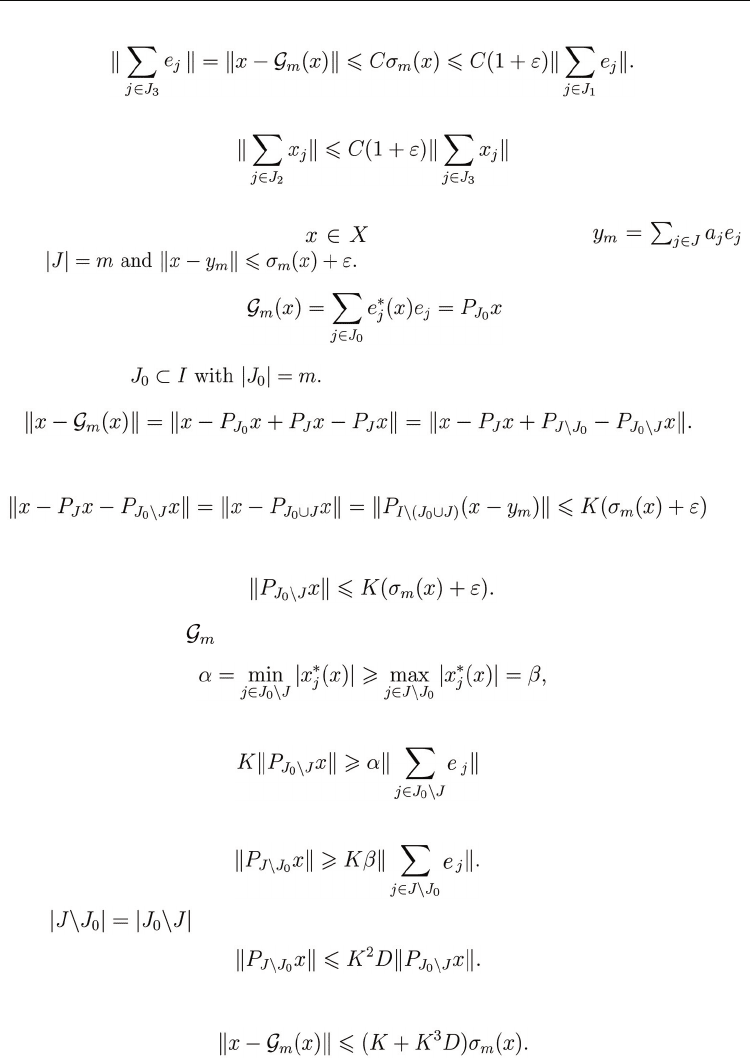
Advances in Greedy Algorithms
334
and
Analogously we get
and the conclusion follows.
Now we will prove the converse. Fix
and m = 0, 1, 2, …. Choose
with
Clearly
for appropriate We write
(15)
Using unconditionality we get
(16)
and analogously
From the definition of we infer that
so from unconditionality we get
(17)
and
(18)
Since
from (17) and (18) and democracy we deduce that
(19)
From (15), (16) and (19) we get ( is arbitrary)
■
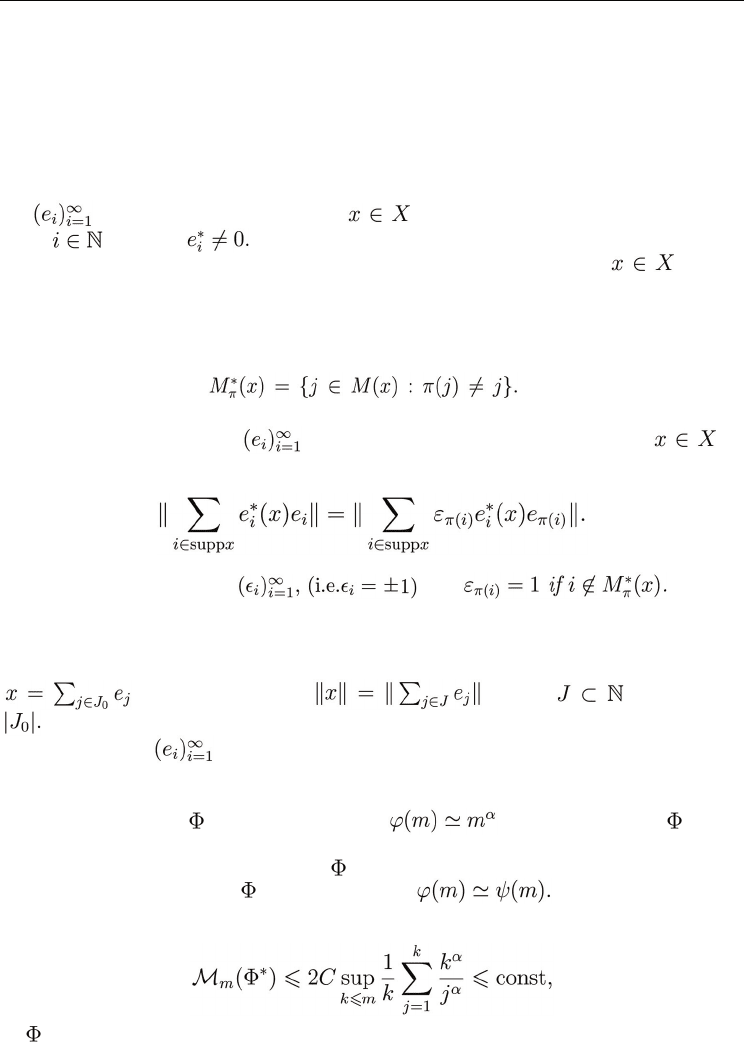
Greedy Type Bases in Banach Spaces
335
Remark 2 The above proof is taken from [26]. However some arguments (except the proof that greedy
implies unconditional), were already in previous papers [32] and [35].
If we disregard constants Theorem 5 says that a system is greedy if and only if it is
unconditional and democratic. Note that in particular Theorem 5 implies that a greedy
system with constant 1 (i.e. 1-greedy) is 1-unconditional and 1-democratic. However this is
not the characterization of bases with greedy constant 1 (see [40]). The problem of isometric
characterization has been solved recently in [2]. To state the result we have to introduce the
so called Property (A).
Let
be a Schauder basis of X. Given , the support of x denoted supp consists of
those
such that Let M(x) denote the subset of supp where the coordinates (in
absolute value) are the largest. Clearly the cardinality of M(x) is finite for all
. We say
that 1-1 map π : suppx → N is a greedy permutation of x if π(i) = i for all i ∈ suppx\M(x) and if
i ∈ M(x) then, either π(i) = i or π(i) ∈ N \suppx. That is a greedy permutation of x puts those
coefficients of x whose absolute value is the largest in gaps of the support of x, if there are any.
If suppx ≠ N we will put
Finally we denote by Π
G
(x)
the set of all greedy permutation of x.
Definition 9 A Schauder basis for Banach space X has property (A) if for any we
have
for all π ∈ Π
G
(x) and all signs with
Note that property (A) is a weak symmetry condition for largest coefficients. We require that
there is a symmetry in the norm provided its support has some gaps. When suppx = N then
the basis does not allow any symmetry in the norm of x. The opposite case occurs when
and J
0
is finite, then for any of cardinality
Theorem 6 A basis
for a Banach space X is 1-greedy if and only if it is 1- unconditional and
satisfies property (A).
Another important for application result is the duality property.
Remark 3 Suppose that is greedy basis and that with 0 <
α
< 1. Then * is also
greedy.
Proof. From Theorem 5 we know that
is unconditional, so we can renorm it to be 1-
unconditional. Also, because
is greedy we have We repeat the proof of
Theorem 4 but in (13) we explicitly calculate as follows:
so
* is greedy
■

Advances in Greedy Algorithms
336
This is a special case of Theorem 5.1 from [11]. We recall that it was proved in [21] that each
unconditional basis in L
p
, 1 < p < 1, has a subsequence equivalent to the unit vectors basis in
l
p
, so for each greedy basis in L
p
we have Thus we get:
Corollary 1 If
is a greedy basis in L
p
, 1 < p < 1, then * is a greedy basis in L
q
, 1/p + 1/q = 1.
4. Quasi greedy bases
In this section we characterize the quasi-greedy systems. The well known result of
Wojtaszczyk [35] says quasi-greedy property is a kind of uniform boundedness principle.
Theorem 7 A natural biorthogonal system is quasi greedy if and only if there exists a constant C
such that for all
and m = 0, 1, 2, … we have
The smallest constant C in the above theorem will be called quasi greedy constant of the system .
Proof. 1⇒2. Since the convergence is clear for x's with finite expansion in the biorthogonal
system, let us assume that x has an infinite expansion. Take
such that
where is a finite set and for . If we take m big
enough we can ensure that
and
Then
This gives 2.
2⇒1. Let us start with the following lemma.
Lemma 2 If 2 does not hold, then for each constant K and each finite set
there exist a finite
set
disjoint from J and a vector
a
j
e
j
such that and
for some m.
Proof. Let us fix M to be the minimum of the norms of the (linear) projections P
Ω
(x) =
where Let us start with a vector x
1
such that and
where K
1
is a big constant to be specified later. Without loss of generality
we can assume that all numbers
are different. For we
have
for some and
Thus
Let us put
and take a finite set J
1
such that for i∉J
1
we have Let us take η very small
with respect to │J
1
│ and │J│ and find x
4
with finite expansion such that If
η is small enough we can modify all coefficients of x
4
from J
1
and J so that the resulting x
5
will have its k biggest coefficients the same as x
3
and Moreover x
5
will have
the form
with J
0
finite and disjoint from J. Since
which
can be made greater or equal K if we take K
1
big enough. ■
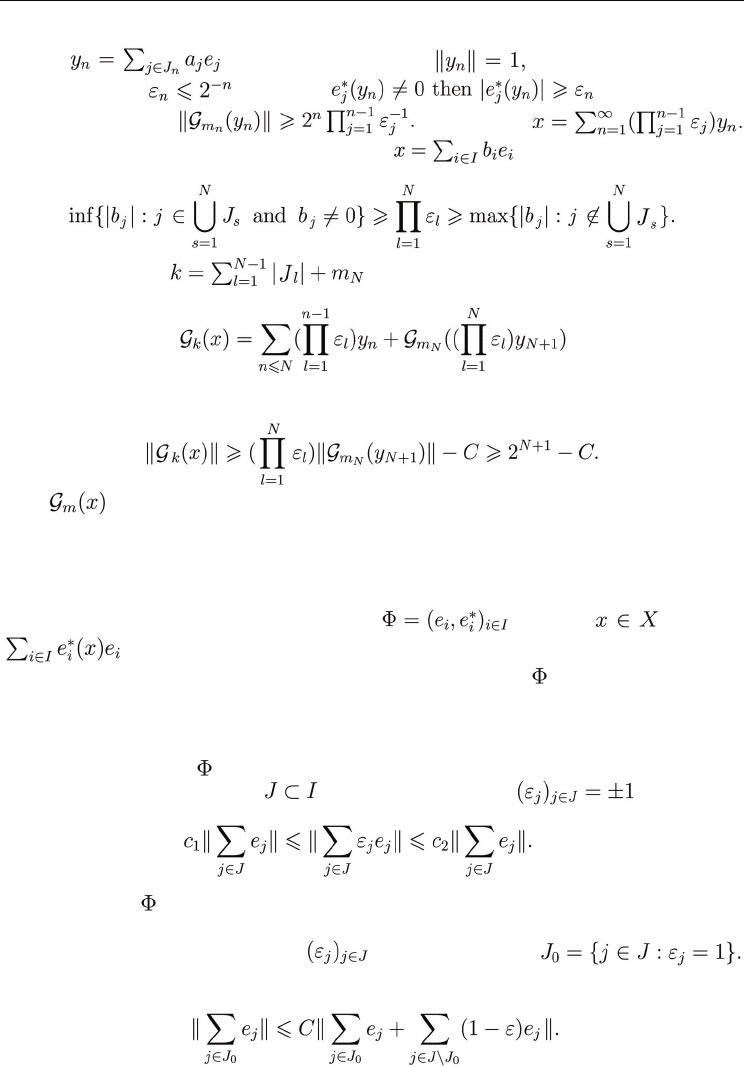
Greedy Type Bases in Banach Spaces
337
Using Lemma 2 we can apply the standard gliding hump argument to get a sequence o the
vectors
with sets J
n
disjoint and a decreasing sequence of
positive numbers
such that if
and a sequence of
integers m
n
such that Now we put
This series is clearly convergent in X. If we write
we infer that
This implies that for
we have
so
Thus
does not converge to x
■
One of the significant features of quasi greedy systems is that they are closely related to the
unconditionality property.
Remark 4 Each unconditional system is quasi greedy.
Proof. Note that for an unconditional system
and each the series
converges unconditionally (we can change the order of I). In particular the
convergence holds for any finite-set approximation of I and hence is quasi greedy.
■
There is a result in the opposite direction, which shows that quasi-greedy bases are rather
close to unconditional systems.
Definition 10 A system
is called unconditional for constant coefficients if there exits constants
c
1
> 0 and c
2
< 1 such that for finite and each sequence of signs we have
(20)
Proposition 3 If (
) has a quasi-greedy constant C then it is unconditional for constant coefficients
with c
1
= C
-1
and c
2
= C.
Proof. For a given sequence of signs let us define the set
For each > 0 and < 1 we apply Theorem 7 and we get
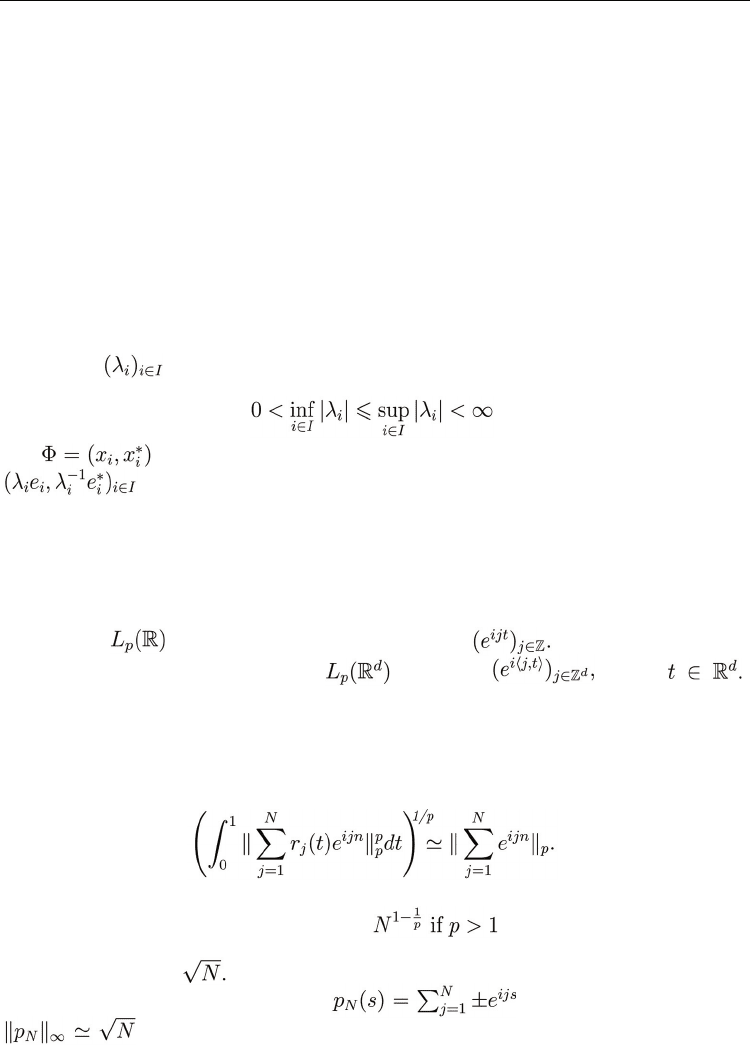
Advances in Greedy Algorithms
338
Since this is true for each > 0 we easily obtain the right hand side inequality in (20). The
other inequality follows by analogous arguments.
■
The quasi greedy bases may not have the duality property. For example for the quasi greedy
basis in l
1
, constructed in [12] the dual basis is not unconditional for constant coefficients
and so it is not quasi greedy. On the other hand dual of a quasi greedy system in a Hilbert
space is also quasi greedy (see Corollary 4.5 and Theorem 5.4 in [11]). Otherwise not much
has been proved for quasi greedy bases.
5. Examples of systems
In this section we discuss a lot of concrete examples of biorthogonal systems. We remark
here that all of the discussed concepts of: greedy, quasi greedy, unconditional symmetric
and democratic systems, are up to a certain extent independent of the normalization of the
system. Namely we have (cf. [40]):
Remark 5 If is a sequence of numbers such that
and is a system which satisfies any of the Definitions 4-8, then the system
verifies the same definitions.
The most natural family of spaces consists of L
p
spaces 1 ≤ p ≤ ∞ and some of their variations,
like rearrangement spaces. As for the systems we will be mainly interested in wavelet type
systems, especially the Haar system or similar, and trigonometric or Wlash system.
5.1 Trigonometric systems
Clearly standard basis in l
p
, p > 1 is greedy. The straightforward generalization of such
system into
space is the trigonometric system Such system may be
complicated to the Walsh system in , given by where
Unfortunately the trigonometric system is not quasi greedy even in L
p
. To show this fact we
use Proposition 3, i.e. we prove that such systems are not unconditional for constant
coefficients whenever p ≠ 2.
Suppose that for some fixed 1 ≤ p < ∞ trigonometric system verifies (20). Then taking the
average over signs we get
The symbol r
j
in the above denotes the Rademacher system. The right hand side (which is
the L
p
norm of the Dirichlet kernel) is of order and of order logN when p = 1.
Changing the order of integration and using the Kchintchine inequality we see that the left
hand side is of order To decide the case p = ∞ we recall that the well-known Rudin
Shapiro polynomials are of the form
for appropriate choice of
while the L
∞
norm of the Dirichlet Kernel is clearly equal to N. This violates
(20). Those results are proved in [40], [30], [8] and [35].
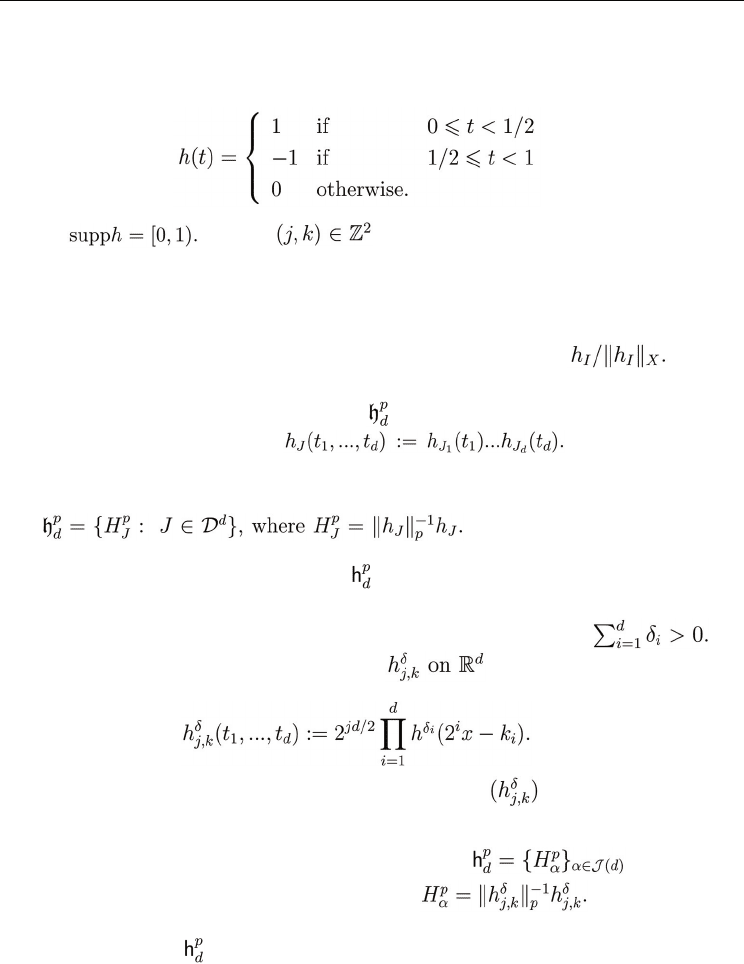
Greedy Type Bases in Banach Spaces
339
5.2 Haar systems
We first recall the definition of Haar system in L
p
space. The construction we describe here is
well known an we follow its presentation from [40]. We start from a simple (wavelet) function:
(21)
Clearly
For pair
we define the function h
j,k
(t) := h(2
j
t - k). The
support of h
j,k
is dyadic interval I = I(j, k) = [k2
-j
, (k+1)2
-j
]. The usual procedure is to index Haar
functions by dyadic intervals I and write h
I
instead of h
j,k
. We denote by D the set of all dyadic
subintervals of R. It is a routine exercise to check that the system {h
j,k
: (j, k) ∈ Z
2
} = {h
I
: I ∈ D} is
complete orthogonal system in L
2
(R). Note that whenever we consider the Haar system in a
specified function space X on R we will consider the normalized system
There are two common Haar systems in R
d
:
1. The tensorized Haar system, denoted by
and defined as follows: If J = J
1
×…×J
d
where
J
1
, …, J
d
∈ D, then we put One checks
trivially
that the system {h
J
: J ∈ D
d
} is a complete, orthogonal system in
L
2
(R
d
). We will
consider this system normalized in L
p
with 1 ≤ p ≤ ∞, i.e.
The main feature of the system is
that supports of the functions are dyadic parallelograms with arbitrary sides.
2. The cubic Haar system, denoted by
defined as follows: We denote by h
1
(t) the
functions h(t) defined in (21) and by h
0
(t) the function 1
[0,1]
. For fixed d = 1, 2, … let C
denotes the set of sequences = (
1
, …,
d
) such that
i
= 0 or 1 and For
∈ C, j ∈ Z and k ∈ Z
d
we define a function
by the formula
(22)
Again it is a routine exercise to show that the system
where varies over C, i
varies over Z and k varies over Z
d
is a complete orthonormal system in L
2
(R
d
). As before
we consider the system normalized in L
p
(R
d
), namely where J (d) =
C × Z × Z
d
and for
α
= (, j, k) ∈ J (d) we have The feature of this
system is that supports of the functions are all dyadic cubes. Therefore one can restrict
the Haar system
to the unite cube [0, 1]
d
. We simply consider all Haar functions
whose supports are contained in [0, 1]
d
plus the constant function. In this way we get
the Haar system in Lp[0, 1]
d
.
The above approach can be easily generalized to any wavelet basis. In the wavelet
construction we have a multivariate scaling function φ
0
(t) and the associated wavelet φ
1
(t)
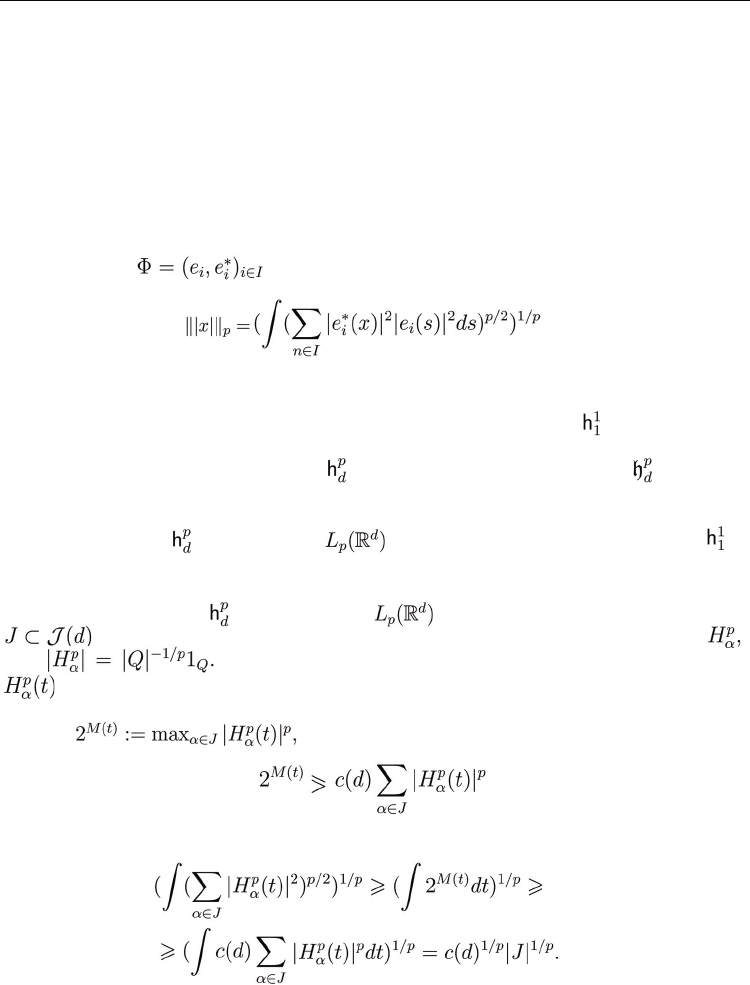
Advances in Greedy Algorithms
340
on L
p
(R). We assume that both φ
0
and φ
1
have sufficient decay to ensure that φ
0
, φ
1
∈ L
1
(R) ∩
L
∞
(R). Clearly functions 1
[0,1]
and h(t) are the simplest example of the above setting, i.e. of
scaling and wavelet function respectively. This concept may be extended to R
d
, i.e we can
define a tensorized wavelet basis, though since we do not study such examples in this
chapter we refrain from detailing the construction.
5.3 Haar systems in L
p
spaces
Since Haar systems play important role in the greedy analysis we discuss some of their
properties. The main tool in our analysis of L
p
will be the Khintchine inequality which
allows to use an equivalent norm on the space.
Proposition 4 If
is an unconditional system in L
p
, 1 < p < ∞, then the expression
(23)
gives an equivalent norm on L
p
.
The above proposition fails for p = 1 but if we introduce the norm given by (23) for p = 1,
then we obtain a new space denoted as H
1
, in which the Haar system
is unconditional.
The detail construction of the space may be found in [37], 7.3.
We show that one of our Haar systems
is greedy whereas the second one is not. We
sketch briefly these results. The first result was first proved in [33] but we present argument
given in [22] and [40] which is a bit easier.
Theorem 8 The Haar
is greedy basis in for d = 1, 2, … and 1 < p < ∞. The
system
is
greedy in H
1
.
Proof. The unconditionality of the Haar system is clear from Proposition 4. Therefore we
only need to prove that
is democratic in for d = 1, 2, … (and also in H
1
). Let
be a finite set. Note that if the cube Q is the support of the Haar function
then
Thus, for each t ∈ R
d
, the non-zero values of the Haar functions
belong to a geometric progression with ratio 2
d
. Then we check that for a given t ∈ R
d
there are at most 2
d
-1 Haar functions which take a given non zero value at this point. Thus
defining
we obtain that
for some constant c(d) > 0. So
We recall that for a given t ∈ R
d
there are at most 2
d
-1 Haar functions which have the same
non zero value at this point. Therefore, following the same geometric progression argument
we see that for each t ∈ R
d
we have
